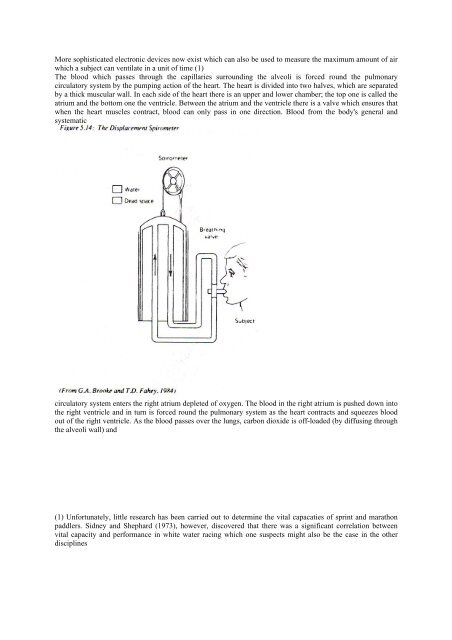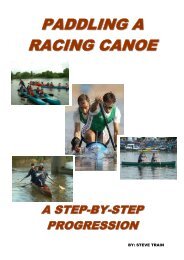- Page 1 and 2:
1 The Science of Canoeing
- Page 3 and 4:
3 Published by Coxburn Press Copyri
- Page 5 and 6:
5 A Word about the Author Dr. Richa
- Page 7 and 8:
Preface The impetus for this book c
- Page 9 and 10:
athletics, rowing and swimming. Bil
- Page 11 and 12:
List of Figures 2.1 Factors Affecti
- Page 13 and 14:
7.11 Other Opportunities to Move Ah
- Page 15 and 16:
Acknowledgements Discussions with m
- Page 17 and 18:
Part A Introduction General introdu
- Page 19 and 20:
Introduction to Factors Affecting p
- Page 21 and 22:
An Introduction to Kinesiology The
- Page 23:
Figure 3.3: The Differences Between
- Page 26:
Trimming the canoe correctly is imp
- Page 29 and 30:
The canoeing technique utilises the
- Page 31 and 32:
Ball and socket joints allow a wide
- Page 33 and 34:
Control of the muscle fibres is by
- Page 36 and 37:
There are three types of muscle con
- Page 38 and 39:
symmetrical halves. Forward and bac
- Page 42 and 43:
Part B Factors Affecting Performanc
- Page 44 and 45:
(FromA.Toro,1986) (1) Here we shall
- Page 46 and 47:
(iii) View from Side 2. The Pull Ph
- Page 48 and 49: Pushing too high with upper arm - o
- Page 50 and 51: (iii) View From Side Coaching Tips:
- Page 52 and 53: Table 4.1: Stroke Times and Percent
- Page 54 and 55: The following tracings are taken fr
- Page 56 and 57: Table 4.3: Paddle Positions and For
- Page 58 and 59: Plagenhoef distinguishes between wh
- Page 61 and 62: Neither paddler in figure 4.15 woul
- Page 63 and 64: Acquiring Good Technique Teaching a
- Page 65 and 66: Stretching exercises should be perf
- Page 67 and 68: Research on canoeists confirms what
- Page 69 and 70: Strength Training There are three b
- Page 71 and 72: Because movement is involved and of
- Page 73 and 74: 73 Table 5.3: Movements and Muscle
- Page 75: Joint Hip Knee Ankle Movement Abduc
- Page 78 and 79: Ideally, subsequent loadings should
- Page 80 and 81: Power Development For the developme
- Page 82 and 83: Since it takes time for physiologic
- Page 84 and 85: Table 5.6 Example of an strength En
- Page 86 and 87: Table 5.12 Characteristics of Isome
- Page 88 and 89: Energy Metabolism in the same way,
- Page 92 and 93: of carbohydrate liberates 36 moles
- Page 94 and 95: Table 5.14: Various Sports and Thei
- Page 96 and 97: Since the demands of lactic trainin
- Page 100 and 101: The volume of oxygen that can be ab
- Page 102 and 103: Oxygen Uptake The volume of oxygen
- Page 104 and 105: Methods of Training Given that ener
- Page 106 and 107: Table 5.15: Guidelines for Writing
- Page 108 and 109: Cat and mouse is simply two or more
- Page 110 and 111: weight each day. Although some athl
- Page 112 and 113: Minerals Like vitamins, minerals ha
- Page 114 and 115: and physically and produce a dehydr
- Page 117 and 118: Post-Competition Since the most eff
- Page 119 and 120: The Nervous System The nervous syst
- Page 121 and 122: (I) A placebo causes an improvement
- Page 123 and 124: haemoglobin and red (oxygen carryin
- Page 125 and 126: Perhaps rather neglected in the lit
- Page 127 and 128: Understanding motivation demands ca
- Page 129 and 130: Personality is often the key to exp
- Page 131 and 132: Intelligence Another important psyc
- Page 133 and 134: Systematically relax different part
- Page 135 and 136: and become more deeply involved. Th
- Page 137 and 138: Tactical and Strategic Factors A Fe
- Page 139 and 140: Knowing that they can then afford t
- Page 141 and 142: eserves of muscle glycogen. If it i
- Page 143 and 144: Fig 7.1 Off the Start (i) 1000m (ii
- Page 145: If you get too far forward you will
- Page 148 and 149:
Figure 7.7 Figure Position This pos
- Page 150 and 151:
It takes considerable practice to b
- Page 152 and 153:
You should remember that as you app
- Page 154 and 155:
If you do wish to go for the lead a
- Page 156 and 157:
Environmental Factors We have alrea
- Page 158 and 159:
Other Factors There are undoubtedly
- Page 160 and 161:
female, will never make a successfu
- Page 162 and 163:
The extreme in mesomorphy is the cl
- Page 164 and 165:
Figure 9.4: C hart for Plotting Som
- Page 166 and 167:
Table 9.5 Descriptive Analysis for
- Page 168 and 169:
alance problem may place a high pri
- Page 170 and 171:
exceptionally light person can usua
- Page 172 and 173:
stroking and stop on the opposite s
- Page 174 and 175:
Since one has no choice over inheri
- Page 176 and 177:
Part C Planning, Administering and
- Page 178 and 179:
preparation before the main competi
- Page 180 and 181:
work. For the marathon paddler, the
- Page 182 and 183:
In the competition period, the grap
- Page 184 and 185:
phenomenon especially amongst marat
- Page 186 and 187:
Note that an endurance base is esta
- Page 188 and 189:
exercise lactic acid concentrations
- Page 190 and 191:
psychological manifest themselves o
- Page 192 and 193:
Men ((ml/kg/)min) Endurance Sports
- Page 194 and 195:
Canoeists often develop lower-back
- Page 196 and 197:
Phase 0 No pain or soreness Phase I
- Page 198 and 199:
Tyldesley, B. and Grieve, J.I. Musc
- Page 200 and 201:
Burke, E. J.(ed), 'Toward an Unders
- Page 202 and 203:
Heller, J. Euro, V. and Kuta, M., `
- Page 204 and 205:
Zuti, W., 'Heat Stress, Conditionin
- Page 206 and 207:
A guide to effective coping with in
- Page 208 and 209:
Appendix Seven Relaxation Technique
- Page 210 and 211:
Major Group 4 - THE LEGS AND FEET A
- Page 212 and 213:
Cue Words and Breathing You can tie
- Page 214 and 215:
Appendix VIII Pre-Competition Quest
- Page 216 and 217:
2) Example of a weekly Micro-Cycle
- Page 218 and 219:
6) Example of a 2 Week Micro-Cycle
- Page 220 and 221:
(4) Examples of O2 Sessions for Int
- Page 222:
On-the-water training sessions, ...



